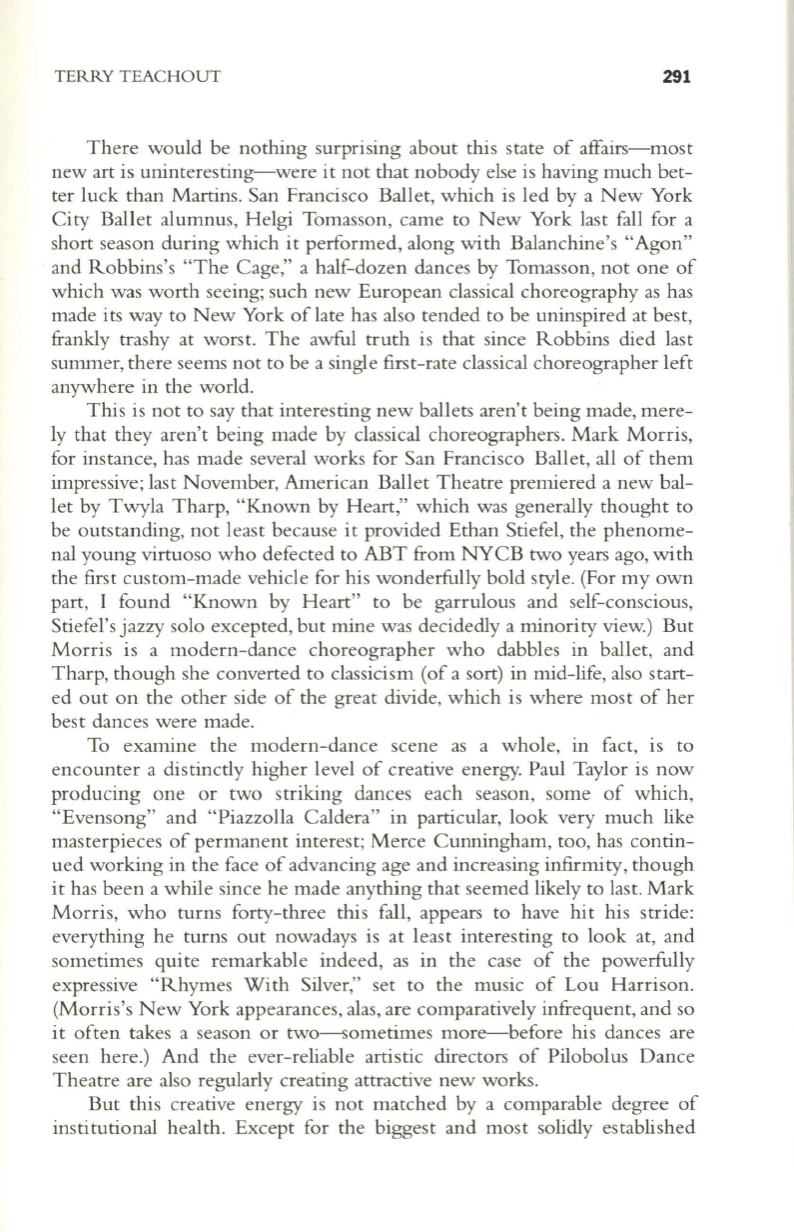
TERRY TEACHOUT
291
There would be nothing surprising about this state of affairs-most
new art is uninteresting-were it not that nobody else is having much bet–
ter luck than Martins. San Francisco Ballet, which is led by a New York
City Ballet alumnus, Helgi Tomasson, came to New York last fall for a
short season during which it performed, along with Balanchine's "Agon"
and Robbins's "The Cage," a half-dozen dances by Tomasson, not one of
which was worth seeing; such new European classical choreography as has
made its way to New York of late has also tended to be uninspired at best,
frankly trashy at worst. The awful truth is that since Robbins died last
summer, there seems not to be a single first-rate classical choreographer left
anywhere in the world.
This is not to say that interesting new ballets aren't being made, mere–
ly that they aren't being made by classical choreographers. Mark Morris,
for instance, has made several works for San Francisco Ballet, all of them
impressive; last November, American Ballet Theatre premiered a new bal–
let by Twyla Tharp, "Known by Heart," which was generally thought to
be outstanding, not least because it provided Ethan Stiefel, the phenome–
nal young virtuoso who defected to ABT from NYCB two years ago, with
the first custom-made vehicle for his wonderfully bold style. (For my own
part, I found "Known by Heart" to be garrulous and self-conscious,
Stiefel's jazzy solo excepted, but mine was decidedly a minority view.) But
Morris is a modern-dance choreographer who dabbles in ballet, and
Tharp, though she converted to classicism (of a sort) in mid-life, also start–
ed out on the other side of the great divide, which is where most of her
best dances were made.
To examine the modern-dance scene as a whole, in fact, is to
encounter a distinctly higher level of creative energy. Paul Taylor is now
producing one or two striking dances each season, some of which,
"Evensong" and "Piazzolla Caldera" in particular, look very much like
masterpieces of permanent interest; Merce Cunningham, too, has contin–
ued working in the face of advancing age and increasing infirmity, though
it has been a while since he made anything that seemed likely to last. Mark
Morris, who turns forty-three this fall, appears to have hit his stride:
everything he turns out nowadays is at least interesting to look at, and
sometimes quite remarkable indeed, as in the case of the powerfully
expressive "Rhymes With Silver," set to the music of Lou Harrison.
(Morris's New York appearances, alas, are comparatively infrequent, and so
it often takes a season or two-sometimes more-before his dances are
seen here.) And the ever-reliable artistic directors of Pilobolus Dance
Theatre are also regularly creating attractive new works.
But this creative energy is not matched by a comparable degree of
institutional health. Except for the biggest and most solidly established


